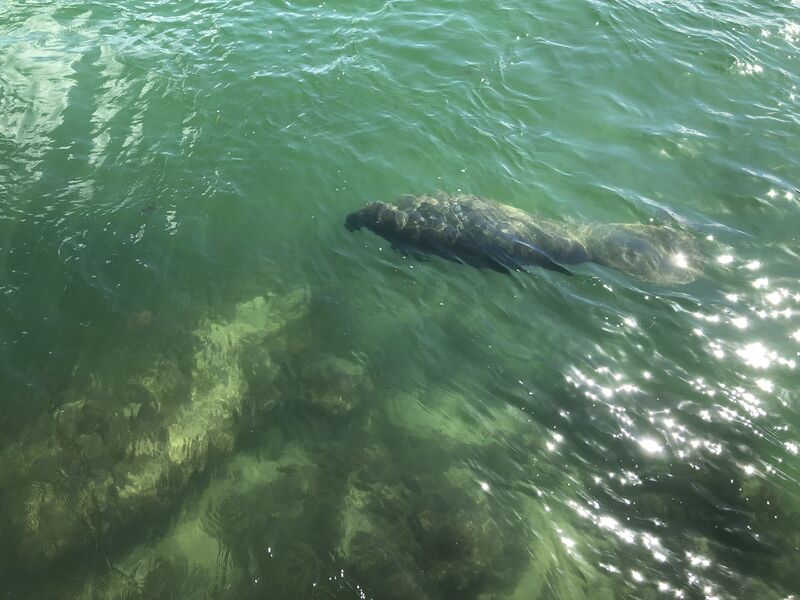Director’s Note: Sarasota Bay is a local exception to bad news on Florida manatee populations
April 5, 2022

2021 was the worst year on record for Florida manatees, with over 1,000 deaths – likely more than 10% of the state’s population. What you may not know is that in the first three months of this year, we are not that far behind what happened last year. During January to March 25th of 2021, we had lost 565 manatees, statewide. Over the same period of time this year, we’ve lost an additional 465 manatees, according to the FFWCC. That is a smaller number than last year, but it is still more than twice as high as the average for the years 2017 to 2020. And because of the hit last year, a slightly smaller number of deaths can be a greater percent decline, due to the reduction in the overall population.
About 3% of the deaths so far this year are “perinatal” and about 39% are females, so this year’s die-off seems to be mostly males and typically not the very youngest manatees. We lost an awful lot of females last year, so it may be that males are disproportionately the survivors of last year’s events.
Sarasota County has only one reported death so far this year, while Manatee County has had three. In contrast, Indian River County has 12, and Brevard County has 290 of the 465 deaths (62%) recorded this year.
Of the 465 dead so far this year, 67% have not been necropsied – most likely due to FFWCC and USFWS staff again being overwhelmed with the number of dead manatees. But the fact that manatee die-offs are centered around Brevard County – as was the case last year - suggests that the manatee die-off is continuing mostly due to starvation, due to a lack of seagrass, due to inadequate water quality in the Indian River Lagoon (IRL). My colleague at the IRL NEP told me that they are starting to see more reports of emaciated dolphins in the IRL, most likely due to the loss of habitat for their major prey species, again due to the collapse of the seagrass ecosystems in the IRL.
A local version of what is happening in the IRL is not out of the realm of possibility, as Sarasota Bay’s seagrass coverage is down by more than 20%, compared to 2016. Tampa Bay has lost 16% of its seagrass acreage since 2018. Charlotte Harbor has lost more than 20% of its seagrass meadows since 2018. In the stretch of Florida between Tarpon Springs and Boca Grande, we have lost about 20,000 acres of seagrass, compared to peak values that occurred within the past decade. In western Florida Bay, we’ve lost about 20,000 acres of seagrass in recent years. And in addition to the > 40,000 acres of seagrass lost from the IRL, Biscayne Bay has lost about 30,000 acres of seagrass in recent years. State-wide, it appears that we may have lost more than 150 square miles of seagrass meadows over the past decade. That’s a lot of fish habitat gone, a lot of water clarity and shoreline protection benefits from seagrass meadows now gone, and a lot less food for manatees and green sea turtles and other sea life.
Thanks to our engaged stakeholders and our educated and committed local elected officials, we are on the right path to recover the water quality and ecosystem health of Sarasota Bay. And the fact that Manatee and Sarasota Counties combined account for less than 1% of recent manatee deaths is a sign that we are one of the better parts of the state, in terms of water quality and estuarine health. But unless other regions start addressing their problems in a more timely manner, it could be that Sarasota Bay becomes even more important to the state than it is now – not only as an example for our nascent ecosystem restoration trends, but maybe even as a refuge of sorts for state-wide manatee populations. Recently, the FWC estimated the in the first 6 months of 2021, the 677 deaths recorded on the east coast was an 18% hit to the population. The additional >300 deaths in Brevard and Indian River Counties this year would thus likely represents an additional 10% reduction in the local population. In addition to deaths in other east coast counties, east coast manatee populations could have declined by as much as a third, over the last 18 months. This could mean that places like Sarasota Bay become more important for manatee populations to survive long-term (in the wild) if the east coast manatee populations continue to decline.
We’ve long known that reducing our pollutant loads and restoring our water quality is important for Sarasota Bay itself, but it could be that we will also have an important role to play to offset problems occurring on the other side of our state. More reason for us to do more, more quickly, to restore our bay’s health.
